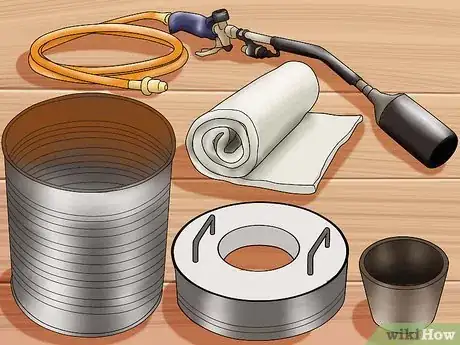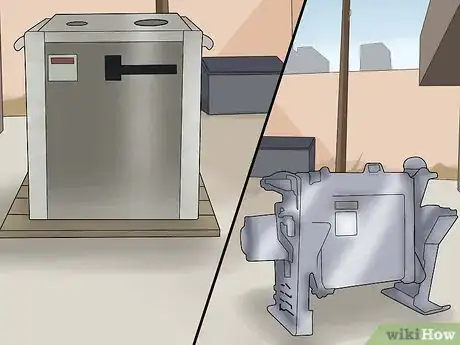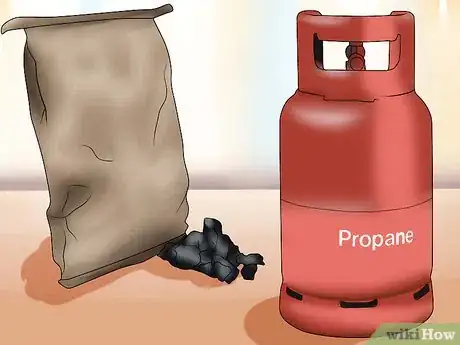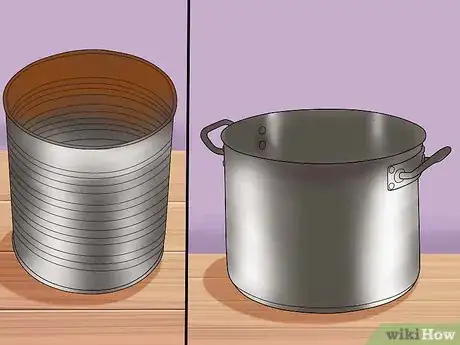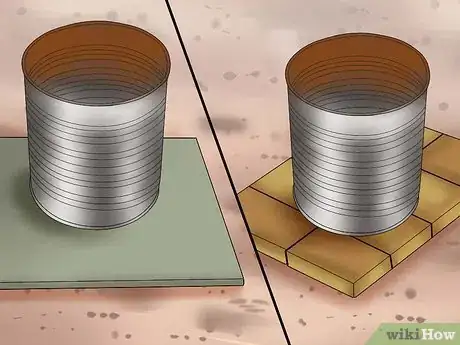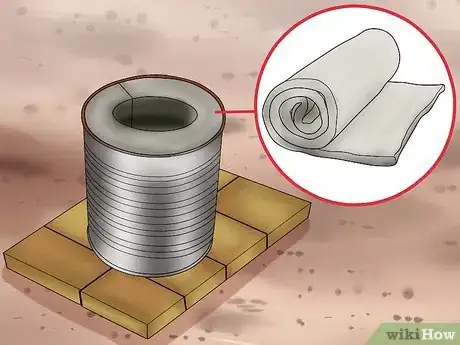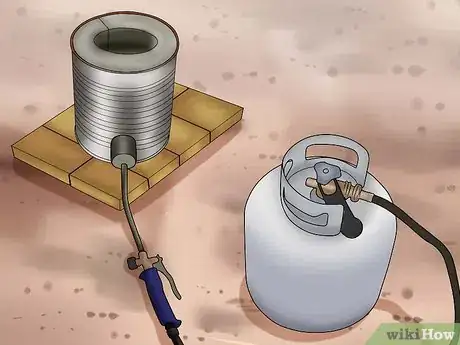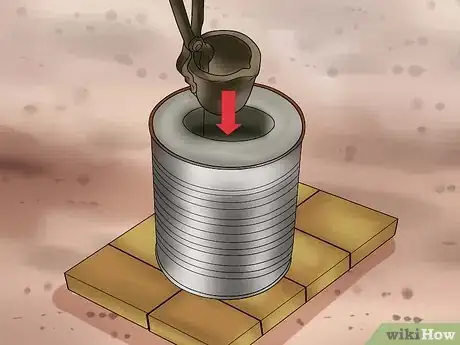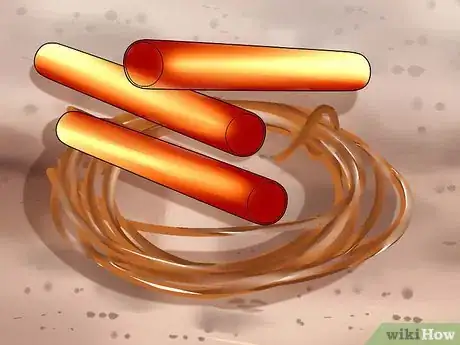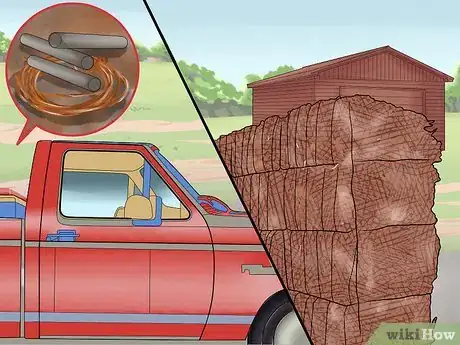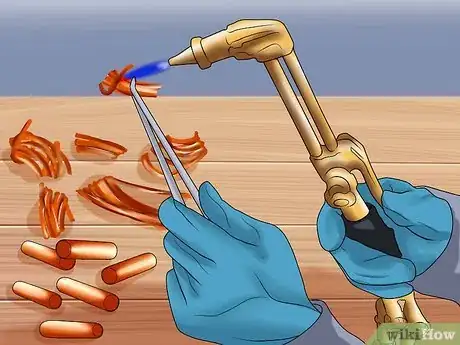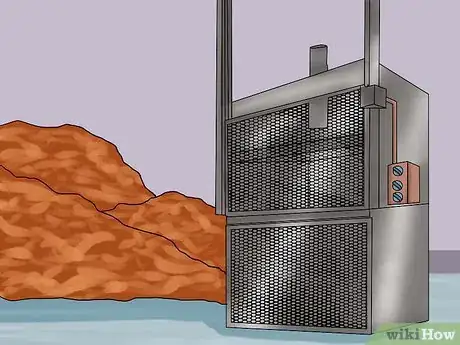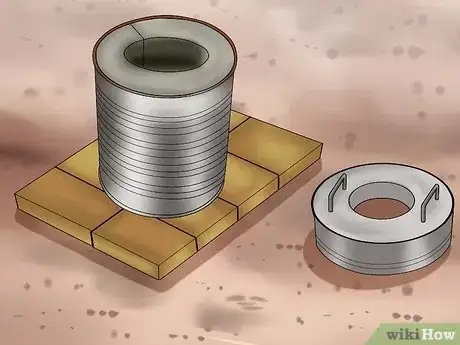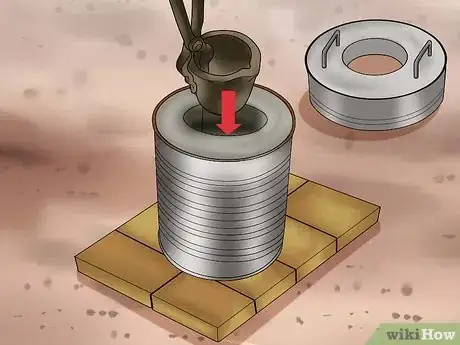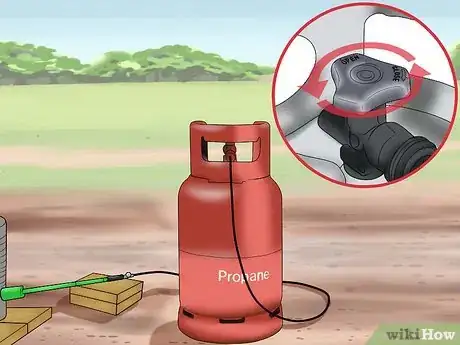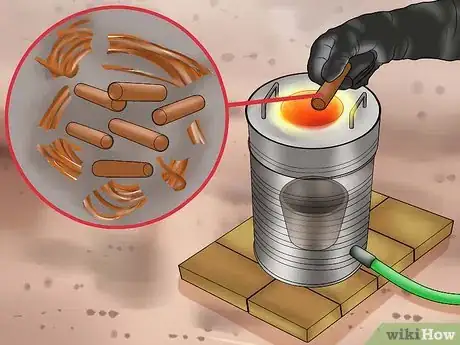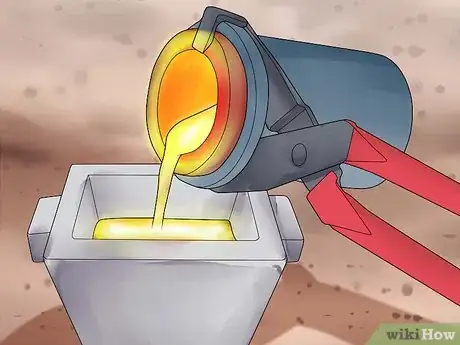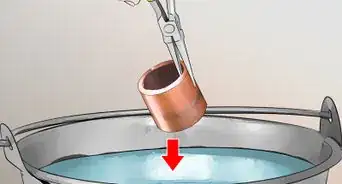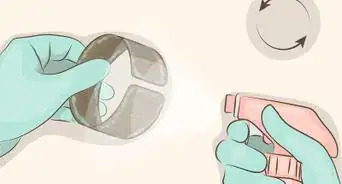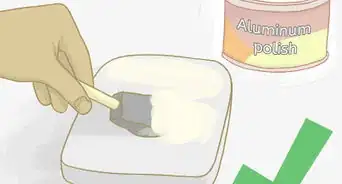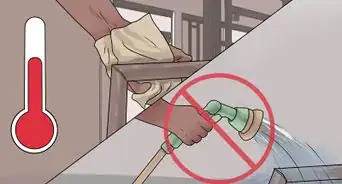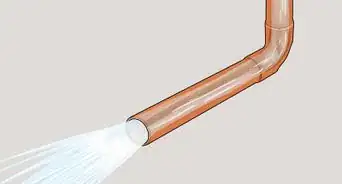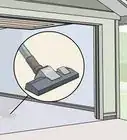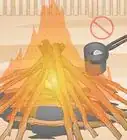wikiHow is a “wiki,” similar to Wikipedia, which means that many of our articles are co-written by multiple authors. To create this article, 16 people, some anonymous, worked to edit and improve it over time.
There are 11 references cited in this article, which can be found at the bottom of the page.
wikiHow marks an article as reader-approved once it receives enough positive feedback. In this case, 91% of readers who voted found the article helpful, earning it our reader-approved status.
This article has been viewed 539,781 times.
Learn more...
Copper is a transition metal that readily conducts heat and electricity, making it a valuable substance in the construction of numerous items. Copper is melted either as ingots for storage or sale, or for casting another object, such as jewelry.
Steps
Preparation
-
1Gather your materials. DIY foundries consist of the furnace body, insulation/lining, crucible, propane tank and burner, as well as a lid. You will also need protective gloves, a suitable face guard, and a set of lifting tongs for moving the crucible. Keep in mind that while is is possible to construct a safe furnace, it is exceedingly important that you properly insulate your foundry to prevent any injury to yourself or others.
- DIY furnace bodies are typically cylindrical and made of metal. Depending on the size of your furnace — which you can determine by the volume of metal you would like to melt — you can use metal cans from bulk food purchases, or a stainless steel crockpot.
- Kaowool (a ceramic fiber with high-heat resistance) is an ideal lining for metal melting furnaces.[1]
- Crucibles are the container in which you will place the metal scraps to be melted. The liquified copper will pool here; it is necessary that you use a material that will not melt or crack at the temperatures needed to melt your copper. Clay graphite is a common choice.[2]
- For the propane burner, you do not want something used for cooking, but instead a torch-like fixture to position through the foundry exterior and by the crucible. These are widely available online.
- The lid will be fashioned out of a smaller top portion of whatever you choose to be your foundry body. Foundry lids have a small hole in the top that allows for ventilation and the prevention of dangerous pressure build-up.
-
2Ensure that your safety equipment is of a high quality. High temperature gloves used in the molten metal industry, as well as a face shield of durable material are recommended. It is useful to know that your flame itself will not be reaching the necessary temperatures; thanks to proper insulation, the crucible center will be super-heated to a point where copper will melt.Advertisement
-
3Use an induction furnace. Because copper has a high melting temperature of 1083°C (1981°F), induction furnaces are typically needed. Although highly expensive industrial machines, induction furnaces will guarantee for a level of safety that is not present in self-constructed foundries. The two most common types are double push-up, and tilting furnaces.[3]
- Double push up furnaces rapidly heat metal in individual "shots" or rounds. The advantage here is that you can start and stop your process easily and not waste energy when only melting a small amount of metal.
- Tilting furnaces are often used in industrial settings. They continuously melt large amounts of copper and are automated to pour into a ceramic container or any desired metal cast/mold.
-
4Obtain necessary fuel. If you decide to build your own furnace, you will need enough fuel to provide a consistent burn. In the casting industry, natural gas is the essential go-to. However, it is also possible to work with charcoal alone.
- Originally metal workers used charcoal and coal. Presently propane and natural gas are used because it saves time and allows blacksmiths to focus on their work.
- One downside of charcoal is that it gives off harmful smoke and will require more attention in maintaining proper temperature.
Foundry Construction
-
1Compose the outer body. For small scale copper metal melting it will be sufficient to create a furnace 6 in. to 1 ft. in diameter. Furnaces are commonly shaped like cylindrical prisms.
- Bulk canned foods (such as peaches and soups) can provide a metal can of the proper size and shape for your DIY furnace.
- For something larger, stainless steel crockpots can also be easily converted into a foundry.
-
2Line the foundry bottom with a kiln shelf brick, or fire brick.[4] This will catch any flux or spilled metal and prevent further to damage to people or materials outside the foundry.
-
3Line the interior floor and walls. Use kaowool. Kaowool is a synthetic mineral wool (sometimes referred to as ceramic fiber) that has a high heat-resistance. It is not necessary to use adhesive between the foundry walls and the kaowool. Simply arch and form the kaowool into place along the curved interior walls; it will hold its form.
- Kaowool is made of a blend of alumina, silica, and kaolin.
-
4Coat the exposed kaowool (which will form your foundry interior) with ITC-100 or satanite. This will increase its durability over time and help to maintain the high temperatures needed to melt copper and other metals.
- ITC-100 is an infrared reflector which will send back up to 98% of the heat that touches it.[5] coating used inside of kilns and elements. Using this can help protect your kiln, and also save fuel.
- Satanite needs to be mixed with water until it forms a pasty solution, and then painted onto the kaowool with a brush.
-
5Drill an entrance hole for the propane tank. Using an electric drill and hole-cutter bit, drill through the foundry exterior roughly two inches above the interior floor's height.
- The entrance should be angled down at roughly 30˚. Should any metal fall from the crucible (or should the crucible break), this will prevent any dangerous material falling into the propane tube.
- The circumference of the hole should be only slightly larger than that of the propane burner, so that is is held securely in place.
-
6Prepare your propane burner. Propane burners for a forge can be purchased online. These important devices attach to your propane tank and create the consistent flame that will be building temperature inside the forge.
- Once the burner is safely attached to your propane tank, slide it snuggly into the pre-drilled entrance.
- Do not insert the burner completely through the hole. The flare should be 1.5in. from the chamber center to protect it from high-temperature damage.[6]
- Always keep your propane tank's valves closed when not in use.
-
7Create a lid. If you are using a can as your foundry, simply cut the top 2 inches off and line the interior with kaowool and a proper coating. Drill a hole in the top of your lid. This will serve to release pressure and allow you to safely add metal scraps into the forge while it is at peak temperatures.
-
8Insert the crucible. Crucibles are made of steel, silicon carbide, and often clay graphite. They resist high temperatures and will hold and heat the copper you are melting. Keep in mind that you will also need proper tongs to grasp the crucible if you intend to pour your liquid copper solution into any molds. Tongs must hold the crucible firmly within slipping.[7]
- If you would like to make your own crucible, you can repurpose old materials like fully used fire extinguishers.
Metal Samples
-
1Obtain copper to melt. Scraps of copper are common in many home appliances and electronics.
- Copper is used to make wires, electronics, appliances and motors, and is therefore commonly found around the house. You can find copper in cookware, furniture, wires and pipes.
- Appliances that utilize copper include air conditioners, dishwashers, heat pumps, freezers, refrigerators, washing machines, clothes dryers, garbage disposals, dehumidifiers, and stoves. Decorative and utilitarian items can also contain copper: fire screens, large clocks, bells, jewelry, etc.
- Be aware that it is illegal to melt U.S. pennies or nickels.[8]
-
2Bring your scraps to foundry location. Depending on the size of scraps this can mean more than just carrying a few wires to your backyard. Potentially you have large, heavy slabs of copper that will require more serious effort to move.
- This may involve either light or heavy-duty trucks, conveyor belts, and potentially stationary or mobile cranes depending on the scale of you operation.[9]
-
3Break and separate your copper pieces. Because of the various shapes of recycled copper pieces, it can be physically difficult to efficiently fit them in a foundry. Working with larger slabs of metal will require heavy manual labor. Commonly the "drop-ball" method is used, which involves using heavy duty machinery to slam the pieces at high speed in order to break it apart.
- Be aware that this process can create a serious safety hazard. Flying pieces of metal quickly become a physical threat. Make sure this process is performed in isolation. Anyone near the operation should be protected by appropriate blockades, walls, etc. to ensure they will not be struck and/or injured.
-
4Torch cut your copper scraps. Once you have reduced all larger pieces of copper to a workable size, use a torch to produce samples that will fit easily in a foundry. Torches using compressed gas are most common in the cutting of metals.[10]
- Always wear a face mask to protect yourself from burning debris.
- Copper has a high heat-resistance and can be difficult (though not impossible) to cut with a gas torch. Plasma torches and powder cutting torches are often used when cutting super-conductors like copper and bronze.
-
5Compact your metal scraps. Use an automated metal baler to pressure high quantities of metal scraps into smaller pieces. Balers are typically made of steel, operating with a hydraulic ram to crush the desired materials.[11]
Melting Process
-
1Position your foundry over sand or dirt.[12] Molten metal can explode if it is spilled and comes in contact with concrete, so it is safest to do your DIY foundry work over dirt and sand, substances that will safely absorb the high-temperature material.
-
2Place the crucible in the foundry. Inspect the interior of your foundry for any foreign objects that could interfere with the crucible's balance or the melting process. Also ensure the crucible is entirely dry. If molten metal comes in contact with foreign objects or water, an explosion can occur.[13] Before lighting your flame, also ensure that the crucible fits securely inside.
-
3Turn on your propane burner. Lighting the flame will begin the process of building a formidable internal temperature high enough to melt your copper. As the charcoal begins to burn, your foundry is almost ready to take in metal scraps.
-
4Cover the foundry with your lid. With only a hole on the top, your foundry should be almost entirely closed off at this point. Now the crucible's interior space can create the intensity needed to superheat whatever scraps of copper will be placed inside.
-
5Place copper pieces in the crucible. As they are already compacted and cut from earlier steps, it should be easy to fit a large amount of pieces in at once, and make your melting process more efficient. Be careful though not to insert so many pieces that, once melted, would cause overflow and breaching of the crucible's lip.
- Always wear heat-resistant gloves and a face guard when beginning the actual metal melting process.
-
6Check the temperature. Copper melts at 1981°F. In order to check that your foundry is hot enough you will need to use a high-temperature thermocouple probe. There are both disposable and reusable models available for purchase from different companies within the metal working industry.
-
7Pour melted copper into a mold or cast. Once the desired amount of copper is ready. Prepare the mold on a safe space (ideally sand or another heat-resistant ground surface. Grasp the crucible with your tongs, lift it from the foundry and slowly pour your liquified copper into the desired cast.
Community Q&A
-
QuestionWhat is the average cost of copper per pound?
 Community AnswerAbout $2.60 a pound as of late, but it fluctuates on an hourly basis. Check KitCo.com for most base prices.
Community AnswerAbout $2.60 a pound as of late, but it fluctuates on an hourly basis. Check KitCo.com for most base prices. -
QuestionCan wire with plastic be placed in a hot crucible?
 Community AnswerYes, but the plastic will produce toxic fumes, so be very careful if you do this and use breathing protection.
Community AnswerYes, but the plastic will produce toxic fumes, so be very careful if you do this and use breathing protection. -
QuestionWhat other metals can be recast using this DIY foundry method?
 Community AnswerIt depends on the maximum temperature of your foundry. Since it's supposed to reach temperatures high enough to melt copper, it should also work for gold, silver, zinc, tin and lead among others.
Community AnswerIt depends on the maximum temperature of your foundry. Since it's supposed to reach temperatures high enough to melt copper, it should also work for gold, silver, zinc, tin and lead among others.
Warnings
- Do not attempt to melt copper without the proper safety equipment as it can be extremely hazardous.⧼thumbs_response⧽
- Extracting copper from ore is much more difficult than melting copper products because the ore contains other substances that must be removed. It is difficult for an individual to obtain copper ore from a mine.⧼thumbs_response⧽
References
- ↑ http://www.bbr-online.co.uk/solutions/portfolio/PDFs/1193.pdf
- ↑ http://www.morganmms.com/content/matching-your-crucible-your-application
- ↑ http://www.copper.org/environment/sustainable-energy/electric-motors/education/motor-rotor/production/proc09/process_09_94.html
- ↑ https://www.abana.org/ronreil/Forge1.shtml
- ↑ http://ronreil.abana.org/design2.shtml
- ↑ http://www.zoellerforge.com/flare.html
- ↑ http://www.fao.org/docrep/009/ah637e/ah637e03.htm
- ↑ http://www.usmint.gov/pressroom/?action=press_release&ID=771
- ↑ https://www.osha.gov/Publications/OSHA3348-metal-scrap-recycling.pdf
About This Article
To melt copper, start by building a foundry using a large metal can or stockpot lined with kaowool and fitted with a propane burner. Then, use a torch to cut large pieces of copper into small bits that will fit in the crucible, which is a container that can withstand high temperatures. Next, place the crucible inside the foundry and turn on the propane burner. Once the copper has melted, use tongs to remove the crucible and pour the liquid copper into a mold. For tips on how to obtain copper that can be melted down and reformed, read on!
